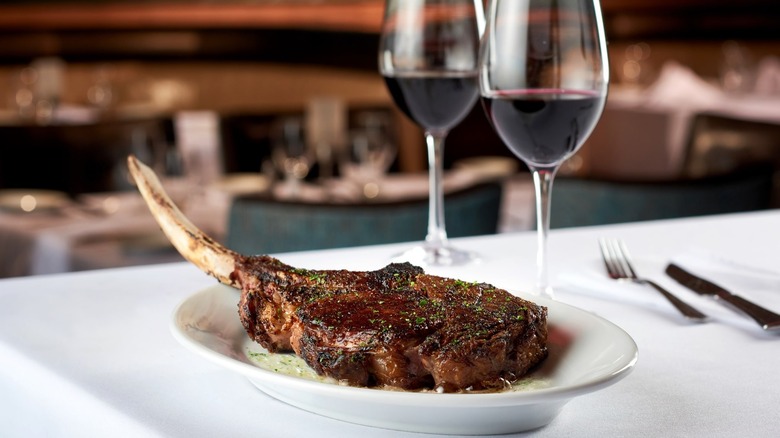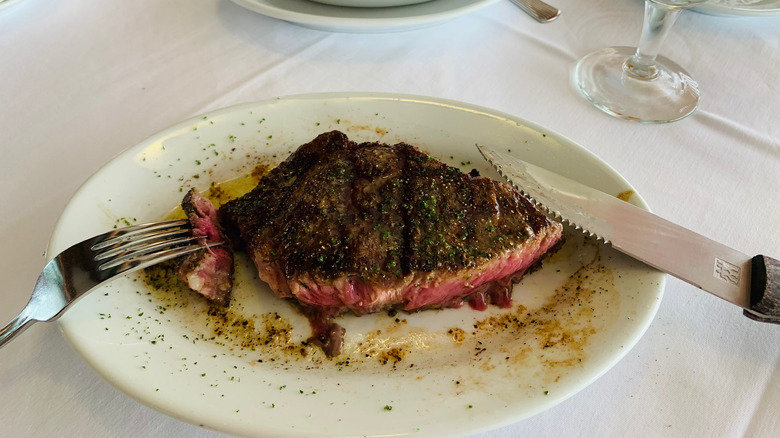The Truth About Ruth's Chris Ribeye Steaks
Carved from the beef rib between the shoulder and the loin, ribeyes are highly coveted among steak connoisseurs. Fatty and high in marbling, they remain juicy and wonderfully succulent even when prepared on very high heat (via Cattlemen's Steakhouse). According to the Ruth's Chris website, this is mainly due to the fact that the high-end cuts come from an area of the cow where the muscles are rarely used, which makes them particularly tender.
Ruth's Chris Steak House was established in 1965 by Ruth Fertel, a single mom who mortgaged her family home to get the project off the ground. Launched as a 60-seat restaurant in New Orleans, over the years Ruth's Chris has grown into a franchise with over 150 outlets across the globe, including far-flung countries such as Mexico, Indonesia, Singapore, and Hong Kong (via Ruth's Chris). And while the restaurant chain serves a varied menu of meat, seafood, soups, salads, and desserts, it's mostly known for its steaks, with ribeyes being one of the most popular items on the menu. Keep reading to find out more about this Ruth's Chris specialty.
Ruth's Chris steaks are sourced from USDA prime cattle
Ruth's Chris prides itself on serving USDA Prime cuts from cattle raised by premium beef suppliers (via Ruth's Chris). But what is prime beef? The United States Department of Agriculture (USDA) classifies beef into three categories. USDA Prime beef, which tops the quality charts, features abundant marbling and is typically sold in high-end restaurants. USDA Choice beef is second in terms of quality. It has less marbling than USDA Prime beef but is still tender and juicy. Last but not least, USDA Select beef comes at the lower end of the scale and tends to be on the leaner and drier side (via USDA).
The beef served at Ruth's Chris is sourced from Midwestern Hereford, Angus, and Shorthorn cattle that is initially fed on grass and then transitioned to eating corn (via Ruth's Chris). This is done to ensure both flavor and quality. Grass-fed beef is said to be more nutrient-dense and sustainable while corn-fed stock tends to be more tender and well-marbled. According to Taste of Home, grass-fed beef is leaner and has a somewhat gamey taste. Cattle that have first been fed on grass and then on corn tend to be bulkier, fattier, and more flavorful.
Ruth's Chris ribeye steaks are wet-aged
Ruth's Chris beef is wet-aged for between 24 and 28 days depending on the cut before it's shipped off to the restaurants. The process increases tenderness by breaking down the enzymes in the meat (via Ruth's Chris). So what's wet-aging and how is it different from dry-aging? Wet-aged steaks are vacuum-sealed in plastic bags and placed in the refrigerator for days or weeks. Dry-aging, on the other hand, involves storing beef in a temperature and humidity-controlled area for around two or three weeks. Dry-aged beef is considered superior to its wet-aged counterpart since it tends to have a more earthy and robust flavor (via Serious Eats).
Since dry-aging is more expensive and takes more time than wet-aging, many restaurants opt for the latter to cut costs. And this is precisely why the founder of Ruth's Chris, Ruth Fertel made the switch. The restaurant used to dry-age its beef in the past but switched to wet-aging to increase consistency and save time and money. Another problem with dry-aged beef was spoilage. As we've previously reported, Ruth Fertel's son said, "Mom weekly lost a few stakes to such taint when customers turned up their noses while Fertel would quickly get the customers a replacement stake. She also believed that the whole experience gave the restaurant a bad reputation ... so she decided to switch to wet-aged steaks."
Ruth's Chris ribeye steaks are made from meat that has never been frozen
Once the wet-aging process is complete, the meat is shipped to Ruth's Chris restaurants fresh — the beef is never frozen (via Ruth's Chris). Freezing meat can be risky since it can affect its texture. This is because the freezing process creates ice crystals that affect the cell membranes of the meat. Lean meat is more likely to suffer from this than fat or connective tissue are. (via Dirty Clean Food).
When ordering ribeye steak at Ruth's Chris you can also rest assured that it has its full nutritional value. While convenient, freezing can lead to loss of nutrients and vitamins, particularly if the beef is incorrectly frozen and stored. According to Meat n Bone, to retain its flavor, texture, and nutrients, a steak should be vacuum-sealed and flash frozen (frozen fast at a very low temperature). It's also important that the meat is frozen immediately after its been cut.
Ruth's Chris ribeye steaks undergo a unique broiling process
What makes Ruth's Chris' ribeye steaks so superior to the cuts we prepare at home is the restaurant's unique broiling process. Ruth Fertel used her knowledge of chemistry and physics — she had degrees in both fields — to design a proprietary broiler that cooks steaks at super high temperatures (via Ruth's Chris). Also, unlike our frying pans at home, the broiler heats up level surfaces to an even temperature. And the end result: perfectly seared and consistently colored ribeye steaks.
Today, all ribeye steaks at Ruth's Chris' are prepared in an infrared broiler. What makes infrared broilers different from cooking with gas or electricity is their ability to radiate heat evenly. Infrared broilers not only heat up quickly but also help chefs make that ribeye to your exact specifications. In addition, what makes Ruth's Chris' broiler so special is its ability to reach extremely high temperatures of up to 1800 degrees Fahrenheit to ensure that your ribeye is both tender and juicy — most conventional broilers won't go higher than 550 degrees Fahrenheit (via Bon Appétit).
Ruth's Chris ribeye steaks are served with the restaurant's signature sizzle
Ruth's Chris ribeye steaks aren't only cooked at roaring hot 1800 degrees Fahrenheit but are also served on 500-degree Fahrenheit plates, a practice that gives the restaurant's dishes their signature sizzle (via Ruth's Chris). Legacy franchisee and operator of Ruth's Chris restaurants in San Antonio and Toronto Lana Duke summed this up for Dine. According to her, Ruth Fertel "wanted the last bite to be as hot as the first. The sizzle in the plate kept it hot to the very last bite ... 'If it doesn't sizzle, send it back.' That helped to build the brand."
While many diners wouldn't have Ruth's Chris' sizzle any other way, some have complained about the restaurant's practice of serving steak on hot plates. One customer wrote on Reddit, "The last time I went to a Ruth's Chris I ordered a medium rare ribeye and they brought it to me on a 500 degree plate, so by the time I was halfway finished with my ribeye it had cooked up to medium well ... the plate was so damn hot it basically ended up ruining my $70 steak." A Ruth's Chris employee said that the restaurant undercooks its steaks and the cooking process is finished on the plate. They also mentioned that diners are welcome to ask for a room-temperature plate or both a sizzling and a standard plate.
Ruth's Chris ribeye steaks are topped with butter
All Ruth's Chris ribeye steaks are served with a dollop — or more precisely tablespoon — of butter, a technique that creates the appealing crackling sound when the hot plate arrives at your table (via Ruth's Chris). A former Ruth's Chris employee explained, "Their little trick is they put clarified butter on the steak as it is leaving the kitchen. The plate is scorching hot because they keep them in the oven and the room temperature butter hits the plate and sizzles for effect" (via Quora). According to KitchenSeer, topping ribeye steak with butter improves the meat's flavor and texture and gives it a glossy finish.
Not everybody has been happy with Ruth's Chris' buttery recipe. A reviewer on Tripadvisor complained that her meal at Ruth's Chris as swimming in butter. "All I could taste was butter! There was literally no flavor to the steak because of it," they wrote. A reviewer on Quora expressed a similar sentiment, "A really good steak does not need to be dripping in butter, much less a 500-degree plate. The last thing I want is butter popping all over a nice white dress shirt and tie." If in doubt, you can always ask the server to prepare your cut sans butter (via Chowhound).
Ruth's Chris ribeye steaks feature minimal seasoning
Forget fancy seasoning because the secret seasoning on Ruth's Chris' steaks is nothing but kosher salt and cracked pepper. This approach lets the quality of the steak speak for itself. It also has other benefits, per the Ruth's Chris website. "The larger grains of kosher salt help create a tasty crust on your steak, and salt also helps meat retain water. Freshly cracked pepper will help to add a crunchy texture and further bring out the flavor of the steak." One Ruth's Chris chef told the Atlanta Journal-Constitution that he recommends adding some fresh garlic to steaks as they're cooking too, but it's unclear if the restaurant does this.
This simple recipe has been a trademark of Ruth's Chris' since its very beginning. In fact, a former employee posted on Reddit that the steakhouse "rarely deviates from anything Ruth [Fertel] implemented herself." Ruth herself has said that one of the secrets of her successful enterprise was consistency — and this, of course, includes seasoning (via Orlando Sentinel). This combination isn't only delicious but over the years has become familiar, which means that customers know exactly what they are getting when they order ribeye steak at Ruth's Chris.







